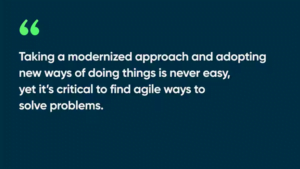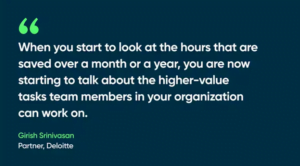Why now is the time to modernize enterprise resource planning

Standing still in a time of rapid technological advancement is not an option for organizational leaders. It’s a necessity to keep pace. With the rise of modern technologies, such as AI and machine learning, it’s a good time to take a step back and examine the landscape of platforms and solutions across an enterprise to determine the best path forward.
Historically, many organizations have relied on SAP enterprise resource planning to integrate business processes into a coherent system. But another modern technology, cloud-based SAP S/4HANA, has forced their hand, creating an imperative to modernize enterprise resource planning (ERP).
To get a clear picture of how organizations can best plan for ERP modernization, I spoke with industry experts on the Innovation Today podcast. We discussed the benefits and challenges of modernization and how the latest technologies can enhance operational and organizational efficiency.
What is ERP modernization?
Although business leaders realize the need to integrate advanced technology into existing processes to stay relevant, they don’t always understand the complexity and costs associated with change.
AI, generative AI (GenAI), and machine learning (ML) are accelerating digital transformation and altering the workplace, says Richard Motteram, chief digital officer at Eviden. “These technologies are becoming more and more relevant to modern business,” he says.
Companies have been building their technology applications for a couple of decades, with many business processes that are core to their operations. Some of these processes may have been built years ago. Because technology has changed dramatically since then, organizations that rely on ERP solutions—specifically SAP—need to understand that modernizing those solutions will take time and resources.

“It’s a massive undertaking, which generates an opportunity. And that opportunity is ERP modernization,” Motteram says. “Take these applications that were built a very long time ago, and look at them with fresh eyes, with the fresh technologies that we have.”
Cloud-based platforms such as ServiceNow that exist outside of SAP may be the answer for some processes, combined with S/4HANA. Motteram calls this type of integration a “better-together solution” by using two modern enterprise platforms.
“The increase in technology, especially in GenAI and the AI space, is bringing technology to more areas of the enterprise,” Motteram explains. As these technologies become more relevant to modern business, so does digital transformation.
Experts say the best practices for transformation include:
- Comprehensively assessing current ERP systems and processes
- Ensuring buy-in from stakeholders
- Partnering with consultants experienced in ERP modernization
- Taking an incremental approach
Small start for long-term wins
ERP modernization can take a few years. Organizations can start by looking for ways to implement solutions that provide fast results.
Girish Srinivasan, a partner at Deloitte, says it’s possible to see measurable success early on. Having an innovation mindset will help teams delve into details of the business to set a clear path for transformation.
He advises that organizations begin looking at the specific business processes that take a lot of manual effort or are difficult for end users. Then take action to simplify those workflows, which, in turn, can save significant time. Those small wins can create a domino effect for success across the enterprise.
“When we talk about value in the context of ERP modernization, it’s the amount of hours you can save,” Srinivasan explains. “And when you start to look at the hours that are saved over a month or a year, you are now starting to talk about the higher-value tasks team members in your organization can work on.”

Removing roadblocks
Abhi Joshi, senior vice president and chief commercial officer at NTT Data Services, says systems that have evolved over the years have been customized to perform tasks they weren’t originally designed for—with many patches along the way.
“That made for a lot of complexity that has crept into the systems,” he says. “It’s very difficult to take all of those customizations and go up the stack without incurring tremendous expenses in project costs and time.”
Rather than look at those challenges as roadblocks, however, Joshi believes education is the key to finding solutions. Taking a modernized approach and adopting new ways of doing things is never easy, yet it’s critical to find agile ways to solve problems.
“You’ve got to look beyond, and things like GenAI are making people think and look beyond,” he says.
Joshi also stresses the importance of finding a champion in the organization. Most often, those stakeholders have identified the issues and created a vision for what they want to improve. Leadership’s involvement, awareness, and buy-in are pivotal to success.
Over the next few years, ERP modernization will be critical to simplifying operations and improving workflows across the enterprise. Transformative technologies are only as powerful as the platform they’re built into. ServiceNow offers the AI platform for business transformation, natively enhanced with AI components at every step.
Find out how Cnergypro helps organizations modernize ERP.
This article first appeared on ServiceNow